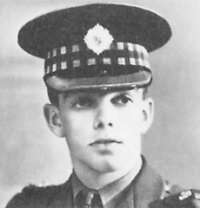Charles Lyell, 2nd Baron Lyell
Charles Antony Lyell, 2nd Baron Lyell, VC, 2nd Bt (14 June 1913 – 27 April 1943) was a British recipient of the Victoria Cross, the highest and most prestigious award for gallantry in the face of the enemy that can be awarded to British and Commonwealth forces.
Charles Antony Lyell, 2nd Baron Lyell | |
|---|---|
 | |
| Born | 14 June 1913 Chelsea, London |
| Died | 27 April 1943 (aged 29) Dj Bou Arada, Tunisia |
| Buried | Massicault War Cemetery |
| Allegiance | |
| Service/ | |
| Rank | Captain |
| Unit | Scots Guards |
| Battles/wars | World War II |
| Awards | |
| Relations | Charles Henry Lyell (father) |
| Other work | County Councillor for Angus |
Background
He was the son of Charles Henry Lyell and his wife Rosalind Margaret Watney.[1] His father died in 1918 and he succeeded his grandfather as Baron Lyell in 1926. He was educated at Eton and matriculated at Christ Church, Oxford in 1932, graduating in 1936. Both his father and his grandfather, Leonard Lyell were Liberal MPs. Between 1936 and his death, Lord Lyell was a member of Boodle's club in St James's, London. He moved to his family's estate in Kirriemuir, Angus before the war where he was a county councillor.
He married Sophie Mary Trafford on 4 July 1938. They had one son, who became Charles Lyell, 3rd Baron Lyell.
His portrait was painted by James McIntosh Patrick in 1940.[2]
Victoria Cross action
Lyell was 29 years old, and a temporary captain in the 1st Battalion, Scots Guards, British Army during the Second World War when the following deed took place for which he was awarded the VC.
During the period 22–27 April 1943 near Dj Bou Arada, Tunisia, Captain Lord Lyell's outstanding leadership and gallantry enabled his company to take its objective. On 27 April accompanied by a sergeant, a lance-corporal and two guardsmen, he led an attack on an enemy post consisting of an 88mm gun and a heavy machine-gun in two separate pits. He destroyed the crew of the machine-gun with a hand grenade and then, three of the party having become casualties, and with the lance-corporal to give covering fire he leapt into the second pit, killing several of the crew before being overwhelmed and killed. Both the guns had been silenced.[3]
He is buried in the Massicault War Cemetery, southwest of Tunis.[4]
References
- "Charles Antony LYELL, Christ Church, Oxford". Archived from the original on 24 February 2013. Retrieved 4 March 2013.
- Billcliffe, Roger (1987) James McIntosh Patrick p.50
- "No. 36129". The London Gazette. 10 August 1943. p. 3625.
- CWGC record
- British VCs of World War 2 (John Laffin, 1997)
- Monuments to Courage (David Harvey, 1999)
- The Register of the Victoria Cross (This England, 1997)
- Scotland's Forgotten Valour (Graham Ross, 1995)
| Peerage of the United Kingdom | ||
|---|---|---|
| Preceded by Leonard Lyell |
Baron Lyell 1926 – 1943 |
Succeeded by Charles Lyell |